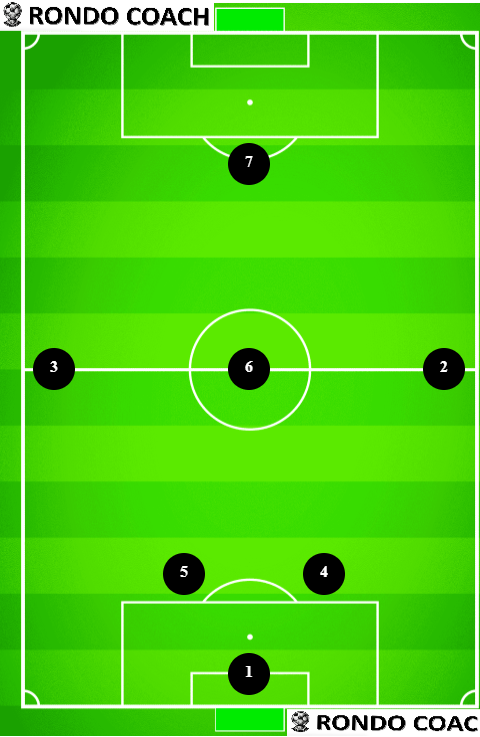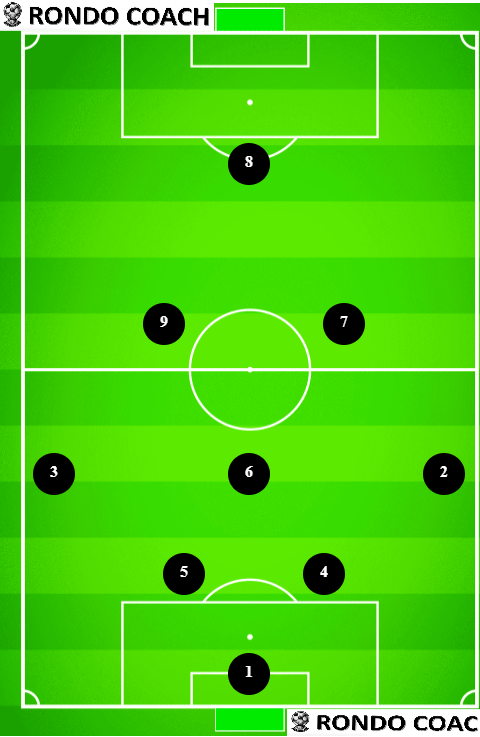Inverted Fullback: Guide to the Tactical Role
When one of my teams moved to play from 7v7 to 9v9 at the U11 level, one of the players came to me disappointed. As you know, I play 2-3-1 and transition to 2-3-2-1, with little difference on the wingbacks. So, the player, a very natural fullback, said it’s boring to play the same role again. Of course, they said they knew everything there is to know about that position. Little did they know that I had a 5-year plan for them to learn things that will make them a complete master of the fullback position. At 9v9 they will learn both overlapping and underlapping runs. However, at the U14 level, the player is ready to discover the Inverted Fullback position. Those that know how to play it effectively, can revolutionize the soccer team they join.
What is the Inverted Fullback Position in Soccer?
The inverted fullback position in soccer is similar to the traditional fullback in defense but plays in the central area of the pitch when the team is in possession. They transition between two positions when the team wins or loses the ball. While playing in a formation of 4 defenders, by inverting, the fullback leaves only 3 players on defense and adds an extra player in the midfield. This effectively makes the team change formations, like 4-3-3 to 3-4-3 or even 3-2-5.
There is no requirement if the inverted fullback is the one from the right or the left side of the pitch. However, only one fullback can do that. When I play with two traditional fullbacks, each of them has the freedom to push higher in the attack. Of course, they would do that only if the ball is on their side. Otherwise, they slide to form a 3-men defense. However, in the inverted fullback role, the side that moves to midfield is already decided as soon as the ball leaves that area of the pitch.
Which formations should I use?
As I said, it has to be at least a formation that starts with 4 defenders. If there are only 3 defenders, it is unlikely that the wider defenders will move to central midfield. More likely, the central defender will push higher, leaving a 2 player defense. However, even that is unlikely. Similarly, in a 3-5-2 formation, the central area is already congested. Of course, you can remove some of that congestion by giving a carrilero role to a player, but it has to be right fit. Furthermore, the wide areas have only the wingback, so they will probably stay hugging the line.
Youth soccer formations and development plan
As I said before, we don’t coach this until U14. Why? Because until then the players need to learn the traditional fullback and winger role. Their positioning is already not ideal and often the middle of the pitch is full of players running after the ball wherever the ball goes. However, by the time they play at U14, they are ready. They had at least a year to play in a 4-3-3 formation. At this point, the wingbacks know how to push up the field and make overlapping and underlapping runs. More importantly, they also know how to slide into a 3 person defensive line.
OK, so now that we have put a player into the central midfield, how will they perform? Well, it depends if you have done the groundwork. At U11, U12, and U13 levels, you have to vary the soccer positions of the players. That doesn’t mean that every player will play at each position. However, a striker should try playing as a winger and attacking midfielder at least. A standard central defender should at least try playing as a holding mid and a wide defender. Even the goalkeeper has to play outfield at this age! So, several of the fullbacks should have experience in playing in the central midfield. This is the time for them to experiment and learn.
When should I use an inverted fullback?
Now that you know how to create these invaluable types of players, you should think about when to use them. Firstly, we need to analyze the advantages of our team and disadvantages compared to the opposition. For example, the talent advantage is that our fullbacks are super fast and are good at crossing to our big strikers. Then we should use that whenever we can. Think about the legendary Manchester United team with David Beckham in it. They needed to get Beckham in a situation where he can cross the ball to the tall strikers. They would never move Gary Neville to invert and play through the middle. You play to our advantage.
However, if you are playing against a team that uses a low block with 1 or 2 attackers pressing the middle, you can really benefit from a 3-2-5 attacking formation. You will overload the front line, but still dominate the middle of the pitch. Their attackers will not have time to hold the ball up, as they will be surrounded by your players.
Note that this is only for patient buildup play. When you plan to have counterattacks, you cannot wait for your fullback to invert. As you probably noticed by now, you shouldn’t plan on doing this when the opponents are dominant in possession. Instead, use this if you know that you will retain most of the possession in the game. Does that mean you will selectively play in this role? Most likely yes, unless you have the technical dominance in the league over everybody else.
Training guide and attributes needed for inverted fullback
We mapped out the time to introduce the inverted fullback role – at the U14 level. However, that’s not day 1 in your development. In fact, that’s just the cherry on top. By then the targeted players should have most of the tools ready. It is your job just to show the final touches on how to fit in the model. By that time they should know how to defend and attack on the wing, slide into a 3-person defense line, throw in and receive from throwing, do overlapping and underlapping runs, and understand how to drop and switch the ball to the other side. Let’s examine when they should learn these skills.
U9 and U10 – 7v7 formation

In our 7v7 tactical analysis, we talked about how we will always play in the 2-3-1 formation. So, the fullbacks are both defenders and wingers. This means that they would learn how to attack the wings, including staying wide, cutting in, and crossing. Let’s not forget that the most important thing for a fullback is to learn how to defend. They need to defend 1v1 but also understand how to transition between attacking and defending. By that I mean, in defense they compress as a team and stay between the opponent and the goal. When attacking, they spread out all the way to the edge of the field. Finally, this is the moment they learn how to throw in – the wide players always take them in this formation.
U11 and U12 – 9v9 formation

As we are in the 9v9 competition for 2 years, the default formation is 2-3-2-1. At this point, the fallbacks have a basic idea of the role they need to play. The two new players will stick mostly to the attacking midfield or the half-spaces. This gives us a perfect opportunity for the fullbacks to learn how to do overlap runs. However, this is also the moment when they need to learn how to form the 3 person defense line with the fullback that doesn’t push up. They will learn how to pass the ball backward and move it across the central defenders to the other side. It sounds simple, but players at their age will never pass backward unless practiced. Never, ever 🙂
As we have two years, we can spend six months on rotating positions, allowing the fullbacks to experience playing in the center of the pitch. However, if you decide to spend half a year on the 3-1-3-1, then the fullbacks can play as wingers. This means they will learn how to receive throw-ins as wingers and also do underlap runs as fullbacks.
U13 and U14 – 11v11 formation
Finally, it’s time for 11v11 and for many 12-year-old kids, it can be overwhelming. Therefore, for the first year, we just stick to the classic 4-3-3. However, then we can pick one of the fullbacks to try and invert. Obviously, we’ll pick games where we are technically dominant. They will practice receiving throw-ins as center midfielder. They would also do underlaps if they played a more attacking role. However, their biggest new experience will be to learn how to switch the ball from side to side. They will learn with the other central midfielders to retain possession and help move the ball from one winger to the other. Similarly, some of them will learn to drift to the side areas, taking the roles of carrileros and mezzalas. At any point they can also look for a pass forward. They can be deadly against lazy defenders that switch off from time to time.
Conclusion
The inverted fullback is gaining popularity in modern soccer tactics. Because of the unpredictability, versatility, and often both technical and physical qualities, players that can play in that position bring high value to the teams they play. Also, that means they are more likely to find a spot in the starting 11. Coaches like the option to change the formation and approach without a substitution.
We covered how to train players for this position and role, from 7v7 in U10, through 9v9 in U11 and U12, all the way to the 11v11 in U13 and U14. After that, you will have players trained in both traditional and inverted fullback roles. With this guide, you will get a good idea of when to use them and how to get advantage over the opponents by deploying your inverted fullback.

